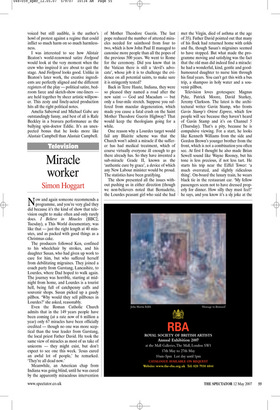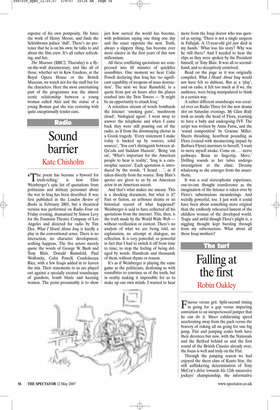Television
Miracle worker
Simon Hoggart
Now and again someone recommends a programme, and you’re very glad they did because it’s the kind of show that television ought to make often and only rarely does. I Believe in Miracles (BBC2, Tuesday), a This World documentary, was like that — just the right length at 40 minutes, and as packed with good things as a Christmas cake.
The producers followed Ken, confined to his wheelchair by strokes, and his daughter Susan, who had given up work to care for him, but who suffered herself from debilitating migraines. They joined a coach party from Garstang, Lancashire, to Lourdes, where Dad hoped to walk again. The journey was horrible, starting at midnight from home, and Lourdes is a tourist hell, being full of catchpenny caffs and souvenir shops. Susan picked up a gaudy pillbox. ‘Why would they sell pillboxes in Lourdes?’ she asked, reasonably.
Even the Roman Catholic Church admits that in the 149 years people have been coming (at a rate now of 6 million a year) only 67 miracles have been officially credited — though no one was more sceptical than the tour leader from Garstang, the local priest Father David. He took the same view of miracles as most of us take of unicorns — they might exist, but don’t expect to see one this week. ‘Jesus cured an awful lot of people,’ he remarked. ‘They’re all dead now.’ Meanwhile, an American chap from Indiana was going blind, until he was cured by the apparently miraculous intervention of Mother Theodore Guerin. The last pope reduced the number of attested miracles needed for sainthood from four to two, which is how John Paul II managed to canonise more people than all the popes of the previous 500 years. We went to Rome for the ceremony. Did you know that in the Vatican there is still a ‘devil’s advocate’, whose job it is to challenge the evidence on all potential saints, to make sure it is stringently tested?
Back in Terre Haute, Indiana, they were so pleased they named a road after the new saint — God and Macadam — but only a four-mile stretch. Suppose you suffered from macular degeneration, which made you cause a fatal crash on the Saint Mother Theodore Guerin Highway? That would keep the theologians going for a while.
One reason why a Lourdes target would fail any Blairite scheme was that the Church won’t admit a miracle if the sufferer has had medical treatment, which of course virtually everyone ill enough to go there already has. So they have invented a sub-miracle Grade II, known as the ‘authentic cure by grace’, a device of which any New Labour minister would be proud. The statistics have been gratifying.
The show presented all the issues without pushing us in either direction (though we non-believers noted that Bernadette, the Lourdes peasant girl who said she had met the Virgin, died of asthma at the age of 35). Father David pointed out that many of his flock had returned home with colds and flu, though Susan’s migraines seemed to have stopped. But what made the programme moving and satisfying was the fact that the old man did indeed find a miracle: he had a wonderful, kind, gentle and goodhumoured daughter to nurse him through his final years. You can’t get this with a bus trip, a shampoo in holy water and a souvenir pillbox.
Television loves grotesques: Magnus Pyke, Patrick Moore, David Starkey, Jeremy Clarkson. The latest is the architectural writer Gavin Stamp, who fronts Gavin Stamp’s Orient Express, which few people will see because they haven’t heard of Gavin Stamp and it’s on Channel 5 (Thursday). That’s a pity, because he is compulsive viewing. For a start, he looks like Kenneth Williams from the side and Gordon Brown’s younger brother from the front, which is not a combination you often see. At first I thought he also made Brian Sewell sound like Wayne Rooney, but his tone is less precious, if not less tart. He starts his trip near the Eiffel Tower: ‘a much overrated, and slightly ridiculous thing’. On-board the luxury train, he wears black tie in the restaurant car. ‘My fellow passengers seem not to have dressed properly for dinner. How silly they must feel!’ he says, and you know it’s a sly joke at the expense of his own pomposity. He hates the work of Henry Moore, and finds the Schönbrunn palace ‘dull’. There’s no pretence that he is on his own; he talks to and about the film crew. It’s all rather refreshing, and fun.
The Museum (BBC2, Thursday) is a flyon-the-wall documentary, and like all of those, whether set in Kew Gardens, at the Royal Opera House or the British Museum, we watch not for the stuff but for the characters. Here the most entertaining part of the programme was the almost erotic relationship between a young woman called Alex and the statue of a young Roman god she was restoring with quite exceptionally tender care.











































































 Previous page
Previous page